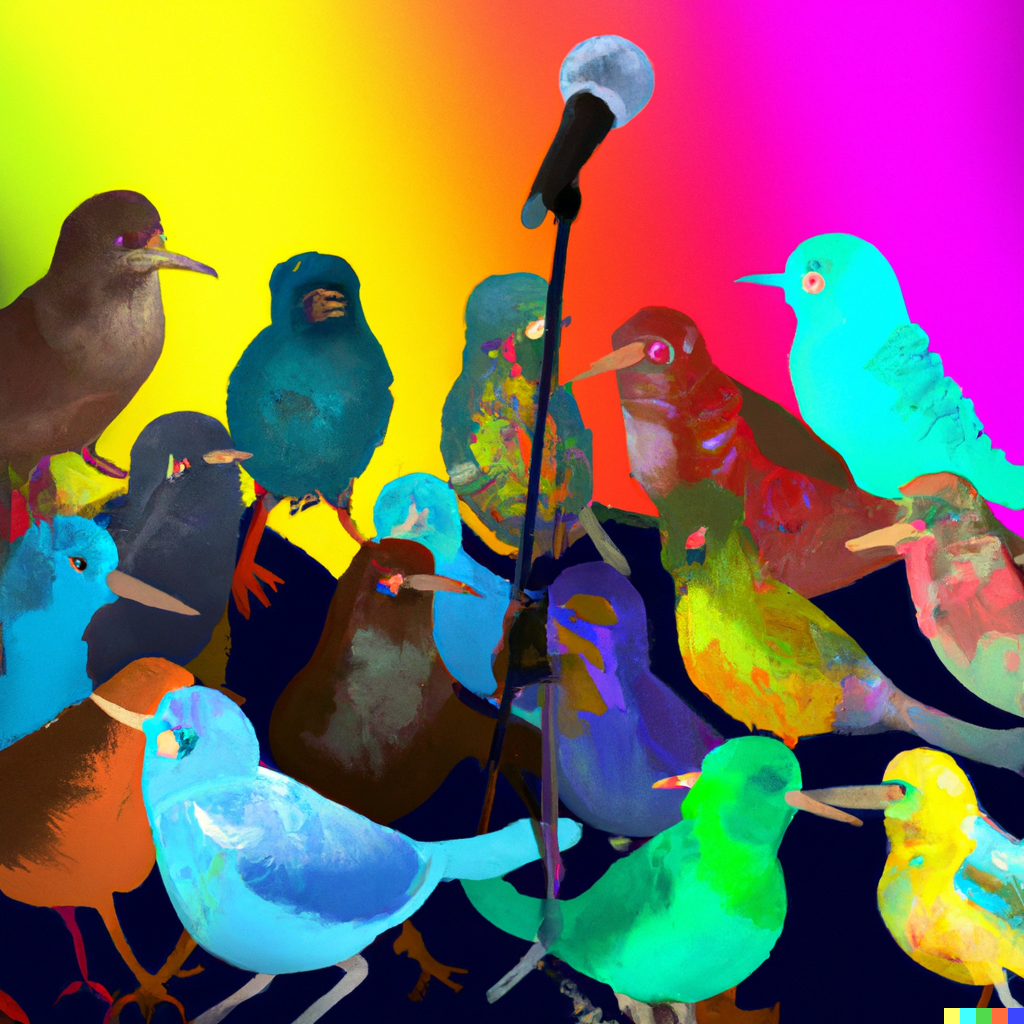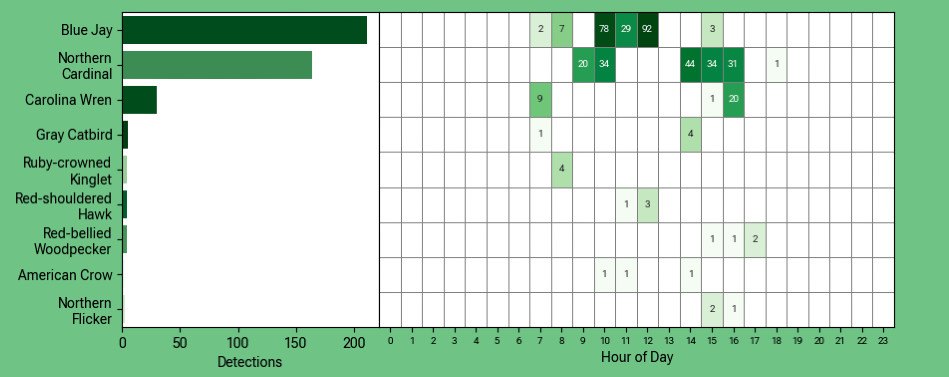
BirdNET-Pi Bird Call Identification System used in Pinpointing Sites with High Ecological Diversity and Resilience to Human Disturbance
Jim Kellam, PhD. Associate Professor of Biology
Saint Vincent College
In the field of Conservation Biology there is a concept called biodiversity. The idea is that an ecological community is stronger—more stable in the face of disturbance—when there are more species present and a meaningful number of individuals from each species. I could explain this in terms of the food chain. The more links in a food chain, the more functional it is, and the less likely any single predator or prey species will become overpopulated or underpopulated. This might make sense to you, but why is it true?
Grass Lawns
For the answer, let me tell you about my neighborhood. I live in a suburban development where everyone has a front lawn. My yard has a sign that reads “Excuse the Weeds, We are Helping the Bees.” The sign was my wife’s idea, and I admit to being a little embarrassed by it, even though it is certainly true that I want to support bees and that our yard has an abundant growth of weeds both in our flower beds and in the lawn. Maybe my embarrassment comes from the peer pressure I feel to conform to society’s ill-fated norm and try to maintain a luscious, weed-free lawn of green grass. I’ve never yielded to that pressure, but I still feel it. If you were to count and identify the species of grasses and broadleaf weeds growing in my yard, and then do the same for my neighbor’s yard, you would find a much larger number of species in my yard than my neighbor’s. The scientific name for the number of species present in a habitat is “species richness.” My yard has greater species richness.
Not only that, but my yard has greater species evenness. This “evenness” idea is that each of the species in my yard is represented by a greater number of individual plants than what you would find in my neighbor’s yard. That is, out of 100 blades of grass in my yard, you might find 20 blades of each of five species. Maybe my neighbor also has five species of grass, but in their case, 90 out of 100 blades of grass would be of Species A and the remaining 10 would be a mix of four other species. Does this make a difference? Yes. First, my yard looks messier because it is a mix of species. But more importantly, when a drought comes, it may impact only one of the four species in my yard, and so overall my lawn is more resilient to drought and won’t turn as brown as my neighbor’s yard. This is indeed what happened this summer when we went through a dry spell.
I used drought as an example of an environmental disturbance. In natural systems, there are lots of kinds of disturbance: wildfire, wind storms, floods, early frosts, and disease outbreaks. There are also the disturbances that humans cause, like pollution, erosion, invasive species introduction, and habitat fragmentation by development. In all these cases, a habitat that has more species and greater evenness will be affected less and recover faster than a habitat that is poorer in diversity. Conservation Biologists thus spend a lot of time trying to measure diversity in terms of species richness and evenness. This helps us understand and predict what might happen in the future.
Bird Communities
I recently taught my Conservation Biology students about this concept and had them use data from the BirdNET-pi network to do some calculations. BirdNET-pi is an artificial intelligence system used at PixCams and Saint Vincent College to identify bird species by their calls and songs in real-time as the sounds are picked up by microphones. It creates a summary grid for each day, showing what hours each species of bird was detected. As an example, today’s summary for the BirdNET-pi station near the Saint Vincent College campus shows that Blue Jays were detected 211 times today. That doesn’t mean we have 211 individual jays, though. The same bird(s) are calling over and over. Therefore, we can’t have an exact count of individuals from these sound data. The students and I got around this by assuming that the more often jay sounds were heard, the more jays were present. Using the hourly breakdown of sound detections, Blue Jays were detected around 7am, 8am, 10am, 11am, 12pm, and 3pm. We counted that as six birds. It’s far from perfect, but it was good enough for a class exercise. The students then made counts like this for all bird species detected over the last seven days.
Winnie Palmer Nature Reserve at Saint Vincent College
Species Richness at Winnie Palmer Nature Reserve was 22 unique bird species.
There were 199 hourly blocks when at least one of these 22 species was calling. But how often did each bird species call? Were those 199 hours dominated by Northern Cardinals with only a few calls from the other 21 species? This can be answered by using an equation called Simpson’s Diversity Index. It is a measure of species evenness.
The Simpson’s Diversity Index calculation used the 199 observations and 22 species to determine that a random draw of 2 observations from those 199 would retrieve two different species 83% of the time. This is a relatively high degree of species evenness (100% is the highest possible value). It suggests that our bird populations at WPNR are not dominated by any single species.
My students weren’t done. I asked them to do the same analysis on the data from a different BirdNET-pi station, in Vienna, Virginia. I chose the Virginia location because I knew the bird species present there would be similar to our collection of birds here in Pennsylvania. It was a better comparison to make than to a dataset from Germany, for example.
Vienna, Virginia
Species Richness in Vienna was 16 species. Not to be competitive or anything, but…YAY, OUR CAMPUS HAS MORE SPECIES than those folks in Virginia!!!!
But remember, the stability of a community is not wholly dependent on the number of unique species, but rather how each one is represented. The species evenness for the Vienna site was 85%, making their community of birds just as stable and resistant against disturbance as ours. So let’s celebrate that. It’s good news. I wouldn’t wish a low evenness score on anyone.
Conclusion
There are shortcomings to this procedure for calculating species richness and evenness from the BirdNET-pi dataset, but I think it holds promise. As more of these devices come online, biologists can use them to pinpoint areas of high species diversity. Such areas around the country and around the world should be protected to ensure the continued existence of life on Earth. I know this sounds extreme, but the value of biological diversity is significant: it leads to fewer impacts from disease, pests, invasive species, storms, floods, fires, pollution, climate change and other disasters.
Credit: Animated image is generated by DALL-E artificial intelligence graphics.


I was recommended this website by my cousin I am not sure whether this post is written by him as nobody else know such detailed about my trouble You are amazing Thanks